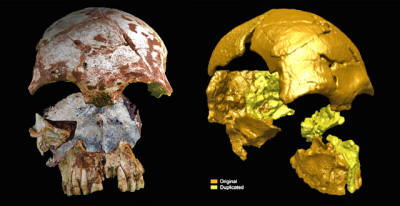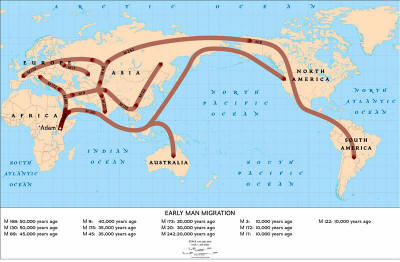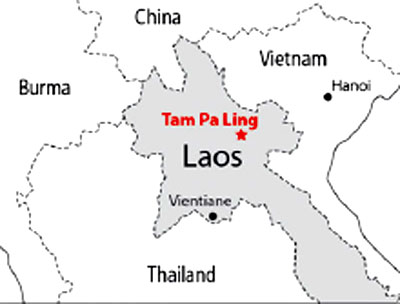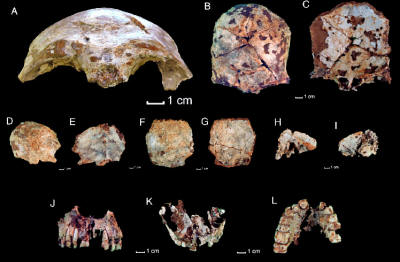|
by John Shanks August 21, 2012 from Sci-News Website
The discovery also bolsters genetic studies that indicate that modern humans occupied that part of the world at least 60,000 years ago, she said.
The scientists used uranium/thorium
dating to determine the age of the skull, which they determined was
about 63,000 years old.
Earliest South Asian Human Discovered from EvoAth Website
Then, ~60,000 years ago, some of our ancestors migrated out of Africa and colonized the rest of the world, out-competing their hominin relatives who were already living in these other regions.
However, new evidence has caused this idea to be revised slightly, resulting in OoA 2. Homo sapiens remains from the Near East reveal that our species made an earlier migration out of Africa ~80,000 years ago, although it ultimately failed.
Further, the other hominins were not
simply wiped out and there was some interbreeding between us and
them, although not much.
Also, non-Africans have less genetic diversity consistent with a bottleneck event (when a small portion of the population migrates, taking with them only a small portion of the genetic diversity of the original). However, evidence for the second point is a bit more sketchy.
Whilst it is true that the only evidence
of successful human migration is less than 60,000 years old there
are only a handful of specimens from that crucial time.
How humans spread
through the world. As such our picture of that period is very low resolution and as new finds increase its clarity we may find something that surprises us.
In particular South Asia contains very few hominin skeletons from this period as its warm, wet climate does not preserve skeletons well. As a result we only have three or so South Asian specimens from 30 - 60,000 years ago, the oldest modern human one dating to ~36,000 years ago. Or at least, it was the oldest until now.
A new specimen from Laos has been is
claimed to be the oldest modern human recovered from the region.
Location of the cave
of the monkey The find itself comes from Tam Pa Ling cave, which (in a twist of irony) means “Cave of the Monkey“.
Archaeologists also found charcoal fragments in the cave which they performed radiocarbon dating on, giving them an age of ~56,000 years old. However, most of the C-14 used in radiocarbon dating has decayed by this point making results from a sample this old very inaccurate.
So they also performed U-series dating
on the skull itself since that method still works at this age range,
which gave a maximum age of ~63,000 years old (+/- 6,000 years).
Reducing that error is key, since at the high end it could cause a
re-evaluation of OoA2, at the low end it would be very interesting
but not quite so revolutionary.
As such any measurement of the surrounding soil will provide a date of burial, not of the age of the fossil itself. However, that can still provide a lower boundary for the age of the find - it must have died before it was buried after all.
So they also performed optically stimulated thermoluminescence dating on the soil the specimen was found in.
OSL dating is really cool and is based off the fact that certain sediments “trap” energy from radioactive decay occurring in the surrounding rocks. This energy is released when it is “excited” by light, meaning that how much has accumulated is basically a measure of how long it was last exposed to sunlight.
The result was 46 - 51,000 years ago,
providing the date of burial but sadly not helping narrow down when
the creature lived.
That said there are some landmarks on the cranium which can be used to identify the species, Neanderthals having a suprainiac fossa on their cranium (which humans lack). When you look at such traits you find this skull lacks all the features unique to archaic hominins whilst possessing all the derived characteristics that identify modern humans.
As such we can be confident this is a
modern human, despite the fact we only have a cranium. The bones recovered from the cave. Note, some are photographs of the same bone from multiple angles.
A cookie to whoever
can identify how many bones are actually there. So we have a modern human who lived in South Asia between 51,000-63,000 years ago, being washed into a cave and buried 46,000-51,000 years ago.
He lived around the time people were successfully migrating to the region and so was an early inhabitant of the region, if not the earliest. This migration was rapid, with genetic evidence indicating people quickly settled the region.
The fact that this specimen is so old supports this idea, showing that people had moved into the region not long after they had left Africa.
Hopefully further analysis of this find - and with any luck more discoveries from the Cave of the Monkeys - can provide further information on the peopling of South Asia.
References
|




